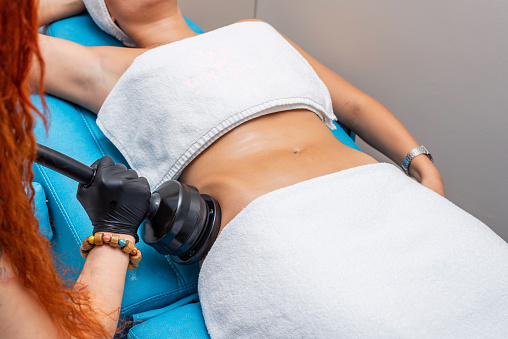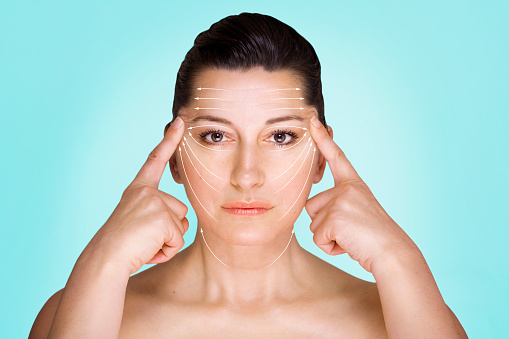Skin tightening treatments can be suitable for individuals of different ages, depending on their specific needs and goals. Generally, skin tightening treatments are most commonly sought after by individuals in their 30s and 40s who may start to notice the first signs of skin laxity, such as fine lines, wrinkles, and sagging skin.
However, skin tightening treatments can also be beneficial for older individuals who have more advanced signs of skin aging, such as deeper wrinkles, folds, and significant skin sagging. In some cases, skin tightening treatments may even be recommended for younger individuals who have experienced significant weight loss or have excess skin after pregnancy.
It’s important to note that the best age for skin tightening treatment can vary depending on the individual’s skin condition, lifestyle factors, and personal goals. Therefore, it’s recommended to consult with a qualified dermatologist or aesthetician to determine the most appropriate skin tightening treatment for your specific needs.

Can you tighten skin after 50?
Yes, it is possible to tighten skin after the age of 50, though it may require a combination of approaches to see the best results. As we age, collagen production naturally decreases, leading to sagging and loss of elasticity. However, several treatments and strategies can help firm and tighten the skin:
1. Non-Surgical Treatments
- Microneedling: This procedure stimulates collagen and elastin production by creating micro-injuries in the skin, which can help tighten and smooth the skin over time.
- Laser Treatments: Technologies like fractional lasers (e.g., CO2 or erbium lasers) and radiofrequency (RF) treatments stimulate collagen production and tighten the skin.
- Ultherapy: Uses ultrasound to stimulate deep layers of the skin, encouraging collagen regeneration and tightening the skin.
- Thread Lifts: Involves inserting dissolvable threads under the skin to lift and tighten sagging areas. Results are temporary but effective.
2. Topical Treatments
- Retinoids: Topical products containing retinoids (Vitamin A derivatives) can promote collagen production and improve skin elasticity over time.
- Peptides and Growth Factors: These ingredients in serums or creams help stimulate skin regeneration and strengthen skin’s structure.
- Hyaluronic Acid: This hydrating ingredient can help plump the skin and improve its texture, reducing the appearance of fine lines and wrinkles.
3. Lifestyle Factors
- Healthy Diet: A diet rich in antioxidants (such as vitamins C and E) can support collagen production. Foods that promote skin health, like fatty fish (omega-3s), leafy greens, and berries, are helpful.
- Hydration: Drinking plenty of water and using hydrating skincare products helps maintain skin’s elasticity and appearance.
- Sun Protection: Protecting your skin from UV damage is essential for maintaining its firmness and preventing further collagen breakdown.
- Regular Exercise: Exercise improves circulation and can help maintain a youthful appearance by promoting healthy skin regeneration.
4. Surgical Options
- Facelift Surgery: If non-invasive treatments are insufficient, a surgical facelift can tighten and lift the skin for more dramatic and long-lasting results.
- Blepharoplasty (Eyelid Surgery): Tightening the skin around the eyes can address sagging or drooping eyelids that often occur with age.
5. Hormonal Factors
- Hormone Replacement Therapy (HRT): Some women find that hormone replacement therapy helps with skin elasticity during and after menopause, as estrogen loss can impact skin health.
Results will vary depending on the person’s skin type, the treatment used, and how well they follow aftercare. It’s often a good idea to consult with a dermatologist or licensed professional to determine the best course of action for your specific needs.
What age should you start skin tightening?
The age at which one may consider skin tightening treatments depends on a variety of factors, including genetics, lifestyle, and environmental factors. While there is no specific age at which one should start skin tightening treatments, the key is to address early signs of skin aging and prevent further damage.
Generally, individuals in their 30s and 40s may begin to notice the first signs of skin aging, such as fine lines and wrinkles, and may consider preventative skin tightening treatments to maintain skin elasticity and firmness. For those with more advanced signs of skin aging, such as significant skin sagging, skin tightening treatments can still be effective in improving skin tone and texture.
However, it’s important to note that skin tightening treatments are not suitable for everyone and should be based on individual needs and goals. A qualified dermatologist or plastic surgeon can assess an individual’s skin condition and recommend appropriate treatment options.
In addition to skin tightening treatments, practicing good skincare habits such as wearing sunscreen, staying hydrated, and avoiding smoking can help delay the signs of skin aging and promote overall skin health.

How can I tighten my skin after 45?
There are several options available to tighten skin after 45. The best treatment option will depend on the individual’s specific needs and goals. Here are some of the most effective treatments for skin tightening:
- Radiofrequency (RF) treatments: This non-invasive treatment uses radio waves to heat the skin’s deeper layers, stimulating collagen production and tightening the skin. RF treatments can improve the appearance of fine lines, wrinkles, and sagging skin.
- Ultrasound treatments: Ultrasound treatments use high-frequency sound waves to heat the skin’s deeper layers, promoting collagen production and skin tightening. Ultrasound treatments can improve skin texture and firmness.
- Laser treatments: Laser treatments use focused light energy to promote collagen production and improve skin tightness. Laser treatments can also reduce the appearance of fine lines and wrinkles.
- Chemical peels: Chemical peels use a chemical solution to remove the top layer of skin, revealing smoother, tighter skin underneath. Chemical peels can improve skin texture and reduce the appearance of fine lines and wrinkles.
- Microdermabrasion: Microdermabrasion is a non-invasive procedure that uses tiny crystals to exfoliate the skin’s top layer, improving skin texture and promoting collagen production.
- Surgical procedures: For those with more advanced signs of skin aging, surgical procedures such as a facelift or neck lift can provide more dramatic and long-lasting results by removing excess skin and tightening underlying tissues and muscles.
It’s important to note that each individual’s skin is unique, and the best treatment option will depend on the individual’s specific needs and goals. It’s recommended to consult with a qualified dermatologist or plastic surgeon to determine the most appropriate treatment options for your specific needs. Additionally, practicing good skincare habits such as wearing sunscreen, staying hydrated, and avoiding smoking can help delay the signs of skin aging and promote overall skin health.
Several treatments can help increase collagen production in the skin, including topical creams and serums, supplements, and cosmetic procedures. These treatments can stimulate the skin’s production of collagen, leading to improved skin texture and firmness.
However, while collagen can help improve skin elasticity and firmness, it may not be enough to achieve significant skin tightening on its own. Collagen supplements and topical products can help improve skin health and appearance, but more advanced treatments such as radiofrequency, ultrasound, and laser treatments may be necessary to achieve significant skin tightening results.
It’s important to note that the effectiveness of collagen treatments can vary depending on the individual’s skin condition, lifestyle factors, and personal goals. Therefore, it’s recommended to consult with a qualified dermatologist or plastic surgeon to determine the most appropriate treatment options for your specific needs and goals.
